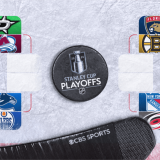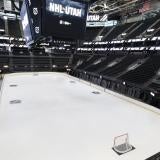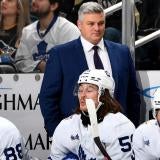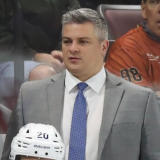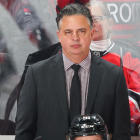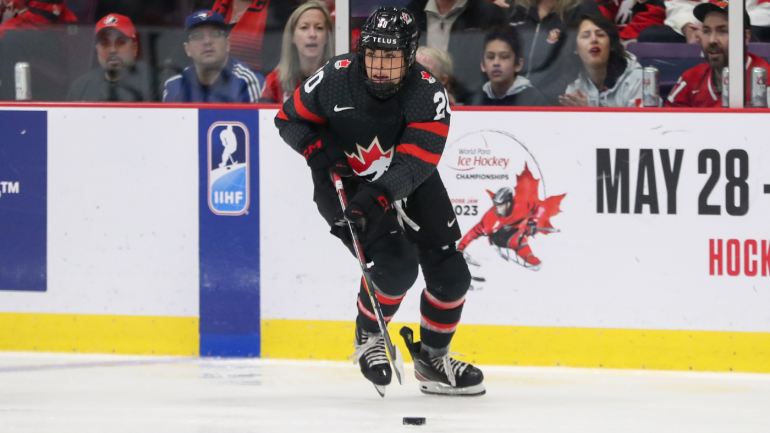
A new North American women's professional hockey league will drop the puck in January. It's been a long time coming for the sport, and the Professional Women's Hockey League (PWHL) hopes to be a lasting version of pro women's hockey.
The new league held a 10-day free agent period where the six founding franchises – Boston, Montreal, Minnesota, Ottawa, New York and Toronto – signed three players ahead of the inaugural draft in Toronto on Monday night. Ninety players will be selected on Monday, with Minnesota holding the first draft pick in league history. Overall, teams must sign 28 players for November training camps and trim their rosters to 23 by puck drop set for 2024.
That leaves 168 total spots for the 268 available players, all of whom had to register to be eligible. CBS Sports spoke to the players in the weeks leading up to the draft. Here are the stories of modern-day women's hockey pioneers and their journeys to the Professional Women's Hockey League.
An Olympian's dream
Sarah Nurse and Kendall Coyne Schofield are among the first 18 players to sign in the PWHL, and rightfully so. Not only are the two Olympic gold medalists with Hockey Canada and USA Hockey, respectively, but they also sat at the negotiating table to deliver the PWHL collective bargaining agreement.
"I have had a lot of eras – as we're in Taylor Swift World right now," Nurse told CBS Sports with a laugh via video conference. Nurse was a year removed from her first Olympics with Hockey Canada when the Canadian Women's Hockey League folded.
She and her countrywomen opted not to play in the then-National Women's Hockey League. Instead, they formed the Professional Women's Hockey Players Association (PWHPA) until a viable and sustainable league was established.
Flash forward to 2023, and Nurse believes we are here and that league is the PWHL. "I feel like we've been everywhere, had our hand and a whole bunch of different pots. But I think it's been pretty exciting, and I'm so happy that we're finally at this point," Nurse said.
"This has been a whirlwind of a journey, and I think this is something that everyone in hockey has wanted to see for a very long time," Coyne Schofield told media during a PWHL Minnesota press conference.
Each signed a three-year contract, Nurse with PWHL Toronto and Schofield PWHL Minnesota, respectively. Although their salaries are undisclosed, Nurse and Coyne Schofield are likely among the six (or potentially more) players who will make $80,000 or more for their respective teams, per the collective bargaining agreement. There is no salary maximum, but the league minimum in the first season will be $35,000 with a league average salary set to $55,000, with a variation of up to 10% "due to player movement and new signings," according to Article 8 of the CBA.
Women's hockey history
Like its sister sports of women's basketball and women's soccer, the PWHL comes after several different versions, including the CWHL and the Premier Hockey Federation (formerly the National Women's Hockey League), which PWHL owners acquired earlier this year. Since the CWHL folded in 2019, many Olympians like Nurse and Coyne Schofield have advocated for a singular women's professional league that meets the highest standard of professionalism possible.
The PWHL's direct roots come from the Professional Women's Hockey Players Association. This group opted not to play in the PHF, instead waiting for what players often called a "truly professional" league. At its acquisition, the PHF operated seven teams throughout North America with a $1.5 million salary cap each. PHF players boasted of their facilities, and Hockey Hall of Famers Angela James and Geraldine Heaney, as well as former director of the USA Hockey Women's Program Reagan Carey, were among the coaches and executives in the league.
However, even a rebrand and several leadership changes could not shed the reputation of the NWHL era, where drastic salary cuts in Season 2 saw a mass exodus by the same U.S. national team players who left the now-defunct CHWL to play in the first-ever women's hockey league to pay its players back in 2015.
Ultimately, PHF owners opted to sell certain assets to the Mark Walter Group, the ownership group funding the PWHL, making way for one pro league in North America. One hundred thirty-eight roster spots will be available in the PWHL, 115 fewer spots than the PHF and PWHPA combined in the 2023-24 hockey season.
Who will be drafted?
The league did not hold a combine ahead of the Draft, so general managers must use an internal talent assessment system and word-of-mouth to assess athletes entering Monday night.
"The list just became final as of midnight on September 3rd, so we're we're doing all of our work, trying to get to know the players want to want to talk to them directly, learn about what what they're looking for out of this opportunity. What drives them? Are they excited to come to Ottawa? Those types of things." PWHL Ottawa general manager Michael Hirshfeld told media during a Sept. 5 video conference. Hershfeld has two temporary staffers and head coach Carla Macleod – who was announced on Sept. 15 – to help with recruitment. "We're working on our list so that we're ready for the draft," Hirschfeld said.
The PWHL provided teams with a list of the registered players and ranked the top prospects. Though all draft-eligible players were invited to attend, only the top players were offered $200 per diem to travel to Toronto. While the league has released the complete list of draft-eligible players, the PWHL has not published its player rankings nor announced the players attending the draft.
The PWHL Draft is akin to an expansion draft in that, whether with the PHF, PWHPA, or leagues across Europe, 85% of the draft pool has professional experience. However, beyond stats for the Olympics – and to some extent college hockey – there is no reliable way to evaluate talent, especially if championships in the CHWL, NWHL, PHF, or abroad are not deemed valuable or "truly professional."
A nine-person committee with ties to women's hockey evaluated and ranked talent ahead of the Draft. That list has been given to PWHL teams and passed along to registered players. PHF veterans like Kaleigh Fratkin are in unknown territory, preparing for Monday. Will their contributions to the recent past of women's pro hockey be enough to secure a spot in its future?
"You can only hope and trust that they did their due diligence to give everyone a fair opportunity," Fratkin told CBS Sports when asked what metrics and information were used to rank her and the other 267 players seeking a roster spot.
"I haven't been offered that information. But I do know there's a committee of nine people involved in that, from my understanding– I think it was a mix of folks from the national team levels with Hockey Canada in the US, as well as some great college coaches," Fratkin said roughly 24 hours after the PWHL held a conference call for all Draft-eligible players.
"So, it is nice to hear – outside of not really knowing the metrics and kind of their ranking process – it's nice to know that there was a good size committee that was offering their input," she added.
So much talent for six teams should guarantee great competition when the puck drops in January. That's what Nurse, Conye Schofield and former CWHLPA executive Liz Knox envisioned.
"It's crazy to me that it took until 2023 for this to happen," Knox said, reflecting on the dream of a women's professional hockey league deferred repeatedly. The former CWHL goalie has since retired from pro hockey but remains an interim board member of the PWHLPA.
"We just weren't quite seeing the business or player experience side tag along with that performance. So it's amazing that it's happening. I feel for the players who, you know, have spent the last five, 10, 15 years pulling the ship along and making this work that might not reap the benefits of it. But I think that there is a message of hope that our kids or our friend's kids will grow up in a world where young boys and girls will watch professional women's hockey on TV, just like any other sport."
Former Metropolitan Riveters captain Madison Packer also acknowledged the trailblazers who came before.
"There have been a lot of people who worked really hard to showcase women's professional hockey in North America that won't be able to do so in the new PWHL," Packer told CBS Sports in a video interview. It was unprompted and the first thing Packer said during the interview.
"Their contributions should always be recognized. Even though they may not continue playing, I have tremendous gratitude and respect for those individuals. And I hope that they feel a great sense of pride when they see the players hit the ice in January, knowing that they have ownership of where women's hockey is today because of their dedication and sacrifice throughout the course of their career."
Making the cut
In reality, Packer might be speaking of herself. The 2018 Isobel Cup champion confirmed she was not among the top-ranked prospects by the PWHL committee and would not travel to Toronto. When CBS Sports first spoke to Packer on Sept. 7, she was hoping to sign with the PWHL New York team under a compassionate circumstance waiver.
The compassionate circumstance waiver is not spelled out in the 62-page CBA but was announced by PWHL Senior Vice President of Hockey Operations Jayna Hefford at an Aug. 29 press conference.
"When players declare for the draft, they have the ability to complete a compassionate circumstance waiver. This would be a situation that is somewhat out of a player's control, that would mean that they just simply cannot relocate to another market because of a given circumstance. We think that's important. Should that be approved, the player would be permitted to play within the markets that they choose," Hefford told media.
In an email to CBS Sports on Sept. 11, the PWHL further clarified a compassionate waiver "will allow a player to be considered to only play in one specific market. The team in the specific market would have the exclusive opportunity, but not the obligation, to negotiate a Standard Player Agreement (SPA) with the player. If a waiver application is denied, or if the team does not enter into a contract with the player, the player may still enter the draft to be considered for any market."
The league noted compassionate waiver applicants would be notified of their status the week before the Draft but has yet to announce how many players applied for waivers nor how many were accepted. In an email to CBS Sports, the PWHL stated there are no minimum or maximum parameters on the waiver process. However, it needs to be clarified if compassionate waiver players must be selected as one of the team's Draft picks on Monday. Either way, players who've been approved and accept their waiver will count towards the required 28-player training camp roster.
Packer confirmed with CBS Sports on Sunday that her application for exclusive negotiations with PWHL New York for a Standard Player Contract was accepted. At this time, Packer is still determining if her waiver status means she will be selected at the Draft or if there is a separate announcement process for players whose waivers were accepted. The Wisconsin alumna and her agent, former NHL player Drew Shore of Wasserman, are keeping lines of communication open.
"That's something that my agent is working on right now, hopefully down to the minute, to determine what it looks like for me from a free agency or restricted agent standpoint," Packer told CBS Sports during a phone call Sunday morning. "I think all of this is new, obviously for everybody. So it's lots of moving parts and not lots of time," Packer said.
In a final follow-up Sunday evening, Packer's agent stated that the PWHL New York team offered her a camp tryout, not an official Standard Player Contract. At this time, Packer has waived her compassionate circumstance status and is eligible to be selected by any PWHL team in the 15-round Draft on Monday.
Always evolving
The moving parts have begun to illuminate what is next for the PWHLPA. While Nurse, Coyne Schofield, and Knox told CBS Sports they believe the players got the majority of their priorities into the CBA, they also know it takes more work and communication to execute its terms fully and what is to come.
"We've barely digested the first meal. Now we're talking about dessert," Knox said. "This is going to be a learn-as-we-go-process, especially for the players because you don't know what you don't know until players are in market and experiencing, essentially, the CBA in play or not. That's when we're going to start to find the holes. We've already seen flickers of it," Knox said, adding she's fielded questions about the compassionate circumstance waiver and other logistics.
No doubt, questions, and logistics remain in the air, but everyone CBS Sports talked to was excited for the future of women's hockey.
"I'm confident at the end of all of it that the best players, regardless of their history, will have a place to play next season, and this is going to be a great league and a good thing to be a part of," Packer said, while also acknowledging this is a difficult time for players who have to wait until after the Draft to negotiate a roster spot, if given the chance at all.
"The Draft is the first of its kind and the first time they're doing all of this in a short period of time. So, just some empathy and grace, I think, should be shown for all parties (Monday), and I'm excited to see what happens."








